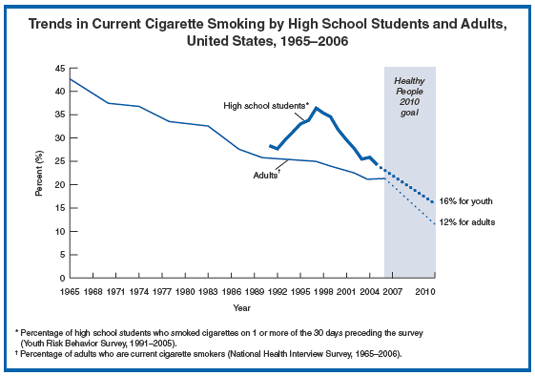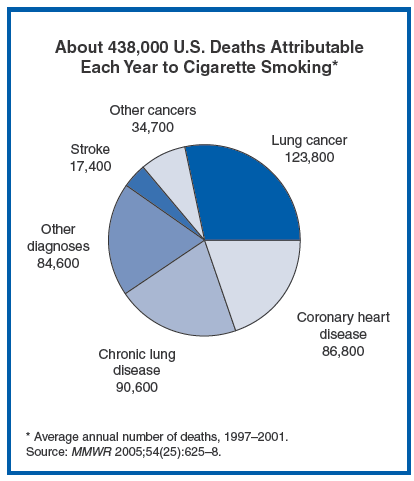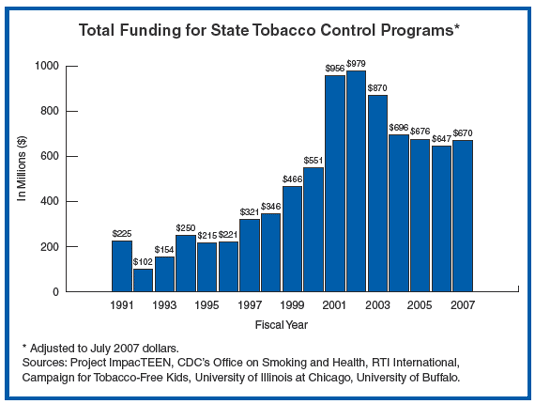 |
|
 |
 |
 |
Targeting Tobacco
Use:
The Nation’s Leading Cause of
Preventable Death
At A Glance
2008
This document is also available in
Portable Document Format
(PDF–241K).
Learn more about PDFs.

[A text
description of this graph is also available.]
“In order to achieve significant decreases in youth and
adult smoking rates, we must further enhance our efforts
and fully implement comprehensive tobacco prevention and control programs.”
Julie Louise Gerberding,
MD, MPH Director,
Centers for Disease Control and Prevention
The Burden of Tobacco Use
Each year, an estimated 438,000 people in the United States die
prematurely from smoking or exposure to secondhand smoke, and another 8.6
million have a serious illness caused by smoking. For every person who dies
from smoking, 20 more people suffer from at least one serious
tobacco-related illness. Despite these risks, approximately 45.3 million
U.S. adults smoke cigarettes.
Coupled with this enormous health toll is the significant economic burden
of tobacco use—more than $96 billion per year in medical expenditures and
another $97 billion per year resulting from lost productivity.
Since 1964, 29 Surgeon General’s reports on smoking and health have
concluded that tobacco use is the single most avoidable cause of disease,
disability, and death in the United States. Over the past 4 decades,
cigarette smoking has caused an estimated 12 million deaths, including 4.1
million deaths from cancer, 5.5 million deaths from cardiovascular diseases,
2.1 million deaths from respiratory diseases, and 94,000 infant deaths
related to mothers smoking during pregnancy. Smokeless tobacco, cigars, and
pipes also have deadly consequences, including lung, larynx, esophageal, and
oral cancers.
The harmful effects of smoking do not end with the smoker. More than 126
million nonsmoking Americans, including children and adults, are regularly
exposed to secondhand smoke. Even brief exposure can be dangerous because
nonsmokers inhale many of the same carcinogens and toxins in cigarette smoke
as smokers.
Secondhand smoke exposure causes serious disease and death, including
heart disease and lung cancer in nonsmoking adults and sudden infant death
syndrome, acute respiratory infections, ear problems, and more frequent and
severe asthma attacks in children. Each year, primarily because of exposure
to secondhand smoke, an estimated 3,000 nonsmoking Americans die of lung
cancer, more than 46,000 (range: 22,700–69,600) die of heart disease, and
about 150,000–300,000 children younger than 18 months have lower respiratory
tract infections.
Smoking rates among youth fell during 2000–2003, but remained unchanged
during 2003–2006. Recent surveys indicate that rates may again be on the
decline among both youth and adults. However, if the nation is to achieve
the objectives in Healthy People 2010, comprehensive, evidence-based
approaches for preventing smoking initiation and increasing cessation need
to be fully implemented.

[A text
description of this graph is also available.]
CDC’s Tobacco Control Framework
As the lead federal agency for tobacco control, CDC is committed to
ensuring that all people, especially those at greater risk for health
disparities, will achieve their optimal lifespan with the best possible
quality of health in every stage of life. With agency-wide health
protection goals that support healthy people in healthy places across
all life stages, CDC is setting the agenda to enable people to enjoy a
healthy life by delaying death and the onset of illness and disability
by accelerating improvements in public health.
With fiscal year (FY) 2008 funding of about $104 million, CDC’s Office on
Smoking and Health (OSH) provides national leadership for a comprehensive,
broad-based approach to reducing tobacco use. A variety of government
agencies, professional and voluntary organizations, and academic
institutions have joined together to advance this comprehensive approach,
which involves the following activities:
- Preventing young people from starting to smoke.
- Eliminating exposure to secondhand smoke.
- Promoting quitting among young people and adults.
- Identifying and eliminating tobacco-related health disparities.
Essential elements of this approach include state-based, community-based,
and health system-based interventions; cessation services; counter
marketing; policy development and implementation; surveillance; and
evaluation. These activities target groups—such as young people, racial and
ethnic minorities, and people with low incomes or low levels of
education—who are at highest risk for tobacco-related health problems.
Sustaining State Programs
CDC continues to support comprehensive programs to prevent and control
tobacco use in all 50 states, the District of Columbia, 7 U.S. territories,
and 7 tribal-serving organizations. In addition, CDC funds national networks
to reduce tobacco use among specific populations. CDC also provides grants
to 23 states for coordinated school health programs to help prevent tobacco
use.
CDC publishes and disseminates accepted best practices to help states
plan, implement, evaluate, and sustain their own tobacco control programs
and also provides technical assistance and training in these efforts. A
substantial body of research demonstrates that comprehensive state tobacco
control programs reduce smoking-attributable mortality, smoking prevalence,
smoking initiation, and cigarette consumption.
Recent research shows that the more states spend on comprehensive tobacco
control programs, the greater the reductions in smoking, and that the longer
states invest in such programs, the greater and faster the impact. If states
sustained their individual recommended level of investment for 5 years,
there would be more than five million fewer smokers nationwide. As a result,
hundreds of thousands of premature tobacco-related deaths would be
prevented. The total recommended annual investment for the nation to fully
fund tobacco control programs is $3.7 billion.
Although this amount may seem high, the cost of this evidence-based
intervention is a fraction of the $13.4 billion the tobacco industry spends
each year to market and promote their products. Further, the level of
investment recommended by CDC is only 2% of the national cost for health
care and lost productivity resulting from tobacco use. This amount could be
funded with just 17% of the nation’s tobacco excise tax and tobacco
settlement revenue.
Key CDC resources for states include the following: Best Practices for
Comprehensive Tobacco Control Programs—2007, Key Outcome Indicators for
Comprehensive Tobacco Control Programs, CDC’s Smoking & Tobacco Use Web
site, the State Tobacco Activities Tracking and Evaluation (STATE) System,
Designing and Implementing an Effective Tobacco Counter-Marketing
Campaign, and Telephone Quitlines: A Resource for Development,
Implementation, and Evaluation.
Expanding the Science Base
CDC is responsible for conducting and coordinating research,
surveillance, laboratory, and evaluation activities related to tobacco and
its impact on health. For example,
- CDC is the lead federal agency responsible for monitoring national
tobacco-use prevalence for youth and adults.
- CDC provides guidance, funding, and technical assistance to help
states evaluate their tobacco prevention and control programs. CDC also
conducts the National Youth Tobacco Survey and assists with the
state-based Youth Tobacco Survey and Adult Tobacco Survey. In addition,
CDC develops survey instruments and methods to help assess tobacco use
in specific populations to complement both state and national estimates.
- CDC, the World Health Organization (WHO), and the Canadian Public
Health Association developed the Global Tobacco Surveillance System to
monitor tobacco use and to help countries plan, develop, implement, and
evaluate their comprehensive tobacco control programs. This system
includes three components—the Global Youth Tobacco Survey, the Global
School Personnel Survey, and the Global Health Professional Survey.
- CDC’s Division of Laboratory Sciences and OSH evaluate additives and
chemical constituents of tobacco and tobacco smoke. This collaboration
includes research on tobacco smoke toxicity and human smoking behavior.

[A text
description of this graph is also available.]
Capitalizing on Unique Opportunities for Research and Collaboration
Communicating Information to the Public
CDC translates research into practice by keeping the public, policy
makers, health professionals, and partners informed on current
developments and initiatives in tobacco control.
- CDC responded to about 18,500 tobacco-related inquiries in FY 2007
and distributed nearly 211,000 publications and video products. Also in
FY 2007, about 5.8 million people visited CDC’s new Smoking & Tobacco
Use Web site.
- In partnership with other federal, state, and local agencies, CDC
provides materials and resources to educators, employers, public health
workers, the media, and other community leaders who are working to
prevent initiation of tobacco use among youth and young adults, promote
tobacco use cessation among adults and youth, eliminate exposure to
secondhand smoke, and identify and eliminate tobacco-related health
disparities.
- Through the Media Campaign Resource Center (MCRC), CDC continues to
provide counter-advertising materials and technical assistance to help
state and local programs conduct effective media campaigns. Through the
Cessation Resource Center (CRC), CDC provides user-tested materials on
topics specific to cessation, such as reimbursement, quitlines, and
evaluation. The MCRC and CRC help states stretch their media budgets by
using and adapting existing ads and other materials rather than creating
new ones.
Promoting Action Through
Partnerships
CDC works with a variety of national and international partners to
ensure that diverse groups are involved in tobacco control efforts. For
example,
- CDC is the lead agency for the 21 national objectives on tobacco use
in Healthy People 2010 and works with other agencies and
organizations to monitor progress toward meeting these objectives.
- CDC staffs the U.S. Department of Health and Human Services’
Interagency Committee on Smoking and Health, which coordinates research
programs and other efforts among federal, state, local, and private
agencies.
- CDC coordinates and promotes tobacco prevention and control
activities with partners, including the American Cancer Society,
American Heart Association, Americans
for Nonsmokers’ Rights, American Legacy Foundation, American Lung
Association, Campaign for Tobacco-Free Kids, National Cancer Institute,
Robert Wood Johnson Foundation, Substance Abuse and Mental Health
Services Administration, Tobacco Technical Assistance Consortium, U.S.
Environmental Protection Agency, World Bank, and numerous national
networks.
- CDC conducts global tobacco control activities with a range of
international, regional, and country-specific partners. CDC, WHO, and
the Canadian Public Health Association have developed the Global Tobacco
Surveillance System, which now includes the Global Adult Tobacco Survey,
funded through the Bloomberg Global Initiative to Reduce Tobacco Use.
- CDC, in partnership with the National Cancer Institute, the North
American Quitline Consortium, and state tobacco control programs, has
developed the National Network of Tobacco Cessation Quitlines. By
calling 1-800-QUIT NOW, callers from across the nation have free and
easy access to tobacco cessation services in their state.
Future Directions
The tobacco use epidemic can be stopped. If all states fully
implemented proven strategies for prevention and control, the nation
could prevent the staggering toll that tobacco use takes on families and
communities. CDC will continue to work with policy makers, health
officials, partners, and the public to ensure that tobacco control
remains a core component of public health domestically and globally.
Agency priorities are to
- Identify the determinants of the stalling decline in youth smoking
rates.
- Sustain and expand the capacity and reach of quitlines.
- Advance the implementation of smoke-free policies.
- Identify and disseminate the evidence base needed to reduce
tobacco-related disparities.
- Help states increase resources for comprehensive tobacco control
programs.
- Investigate the public health implications of smokeless tobacco use.
|
For more information or copies of publications referenced
in this document, please contact
Centers for Disease Control and Prevention
National Center for Chronic Disease Prevention and Health Promotion
4770 Buford Highway NE, Mail Stop K–50, Atlanta, GA 30341-3717
Telephone: 800-CDC-INFO (232-4636) • TTY: 888-232-6348
E-mail: cdcinfo@cdc.gov • Web:
http://www.cdc.gov/tobacco
|
|
Page last reviewed: March 11, 2008
Page last modified: March 11, 2008
Content source: National Center for
Chronic Disease Prevention and Health Promotion
|
|